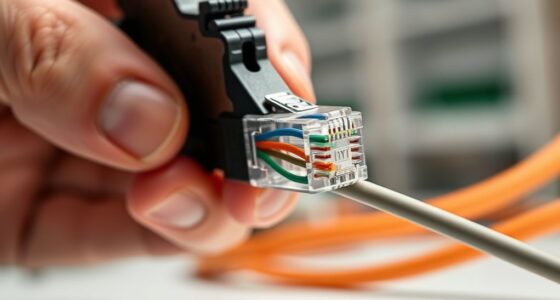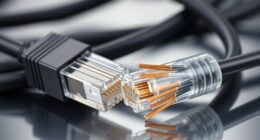When setting up a network, using patch panels can make a significant difference in how you organize and maintain your cables. They serve as central points where multiple connections come together, simplifying troubleshooting and future upgrades. Properly managing your patch panels with labels and cable ties keeps everything tidy and accessible. Understanding how they fit into your overall network design can help guarantee a more reliable and scalable setup—something worth exploring as you plan your installation.
Key Takeaways
- Patch panels centralize cable management, making network setup organized and accessible for easier maintenance.
- Proper port labeling on patch panels speeds up device identification and troubleshooting.
- Using cable management tools like ties and trays prevents tangling and protects cables from damage.
- Well-organized patch panels enhance network reliability by reducing disconnections and interference.
- Clear labeling and organized cabling support scalability and simplify future upgrades or repairs.

Patch panels are essential components in network installations, offering a centralized point to manage and organize multiple cables efficiently. When you’re setting up or maintaining a network, a patch panel helps keep your cables tidy and accessible, preventing a tangled mess that can cause confusion and slow troubleshooting. Good cable management becomes straightforward because you can route cables neatly behind the panel, reducing clutter and making future upgrades or repairs much easier. With a well-organized patch panel, you minimize the risk of accidental disconnections or damage caused by mishandling cables, ensuring your network runs smoothly and reliably.
One of the most effective ways to enhance your patch panel setup is through thoughtful port labeling. When you label each port clearly, you instantly know which device or location each cable connects to, saving you time when managing or troubleshooting the network. Proper port labeling also helps prevent errors, such as unplugging the wrong cable during maintenance or upgrades. You can use labels that are durable and easy to read, even in environments with dust or limited lighting, ensuring your system remains organized over the long term. This practice proves especially valuable in larger networks, where dozens or even hundreds of cables are involved, and quick identification can make a significant difference in reducing downtime. Additionally, effective cable management strategies can improve overall network performance by reducing interference and signal degradation caused by poor cable handling.
Implementing effective cable management strategies alongside port labeling makes your network more professional and scalable. As your network grows, you’ll appreciate how much easier it is to add new connections or reconfigure existing ones without disrupting the entire system. Using cable ties, Velcro straps, or cable management trays helps keep cables aligned and prevents them from tangling or bending unnecessarily. When combined with clear labels, these measures create a visual map of your network, making troubleshooting as simple as following labeled cables from device to patch panel port. This level of organization isn’t just about aesthetics—it directly impacts your ability to maintain, expand, and troubleshoot your network efficiently.
Frequently Asked Questions
How Do I Choose the Right Patch Panel for My Network?
To choose the right patch panel, consider your network’s size and port needs. guarantee it supports your cable management for neat, organized setups, and opt for one with enough ports for future expansion. Look for clear port labeling options to simplify troubleshooting and maintenance. A patch panel with quality construction ensures durability and reliable connections. Matching your existing cabling standards and future growth plans will help you select the best fit.
What Are Common Mistakes to Avoid When Installing Patch Panels?
When installing patch panels, avoid poor cable management by keeping cables organized and avoiding tangles. Follow labeling best practices to clearly identify each connection, making troubleshooting easier later. Don’t overload ports or force cables into connectors; this can damage equipment. Also, verify proper grounding and secure mounting. Regularly inspect and maintain your setup, preventing issues before they arise. These steps help ensure a reliable, efficient network installation.
Can Patch Panels Be Used for High-Speed or Fiber Optic Networks?
Think of patch panels as the backbone of your network. Yes, they can be used for high-speed and fiber optic networks, but only if they’re designed for it. Make sure your patch panel offers fiber optic compatibility and supports high-speed capabilities to handle data demands. Otherwise, you’re building a house on shaky ground, risking slowdowns or failures. Choose the right patch panel to keep your network strong and future-proof.
How Do I Troubleshoot Connectivity Issues With Patch Panels?
To troubleshoot connectivity issues with patch panels, start by inspecting cable testing results to identify any faulty or damaged cables. Check for signal interference from nearby electronic devices that may disrupt signals. Confirm all connections are secure and properly seated. Use a cable tester to verify continuity and proper wiring. If problems persist, replace suspect cables and re-test to verify restored connectivity, reducing downtime and ensuring reliable network performance.
What Maintenance Is Required to Keep Patch Panels Functioning Properly?
Think of your patch panel like a garden; regular maintenance keeps it flourishing. You should follow cleaning protocols to remove dust and debris that can hinder connections. Additionally, maintain clear labeling practices so you can quickly identify and troubleshoot cables. Periodically inspect for loose or damaged connections, and ensure ports are free from corrosion. Consistent upkeep prevents downtime and keeps your network running smoothly, much like tending a healthy garden.
Conclusion
Think of patch panels as the conductor of your network orchestra, guiding every cable to play in harmony. When you organize with proper labeling and tidy cables, your system runs smoothly like a well-oiled machine. It’s your ticket to a network that’s reliable, scalable, and easy to troubleshoot. So, embrace patch panels—they’re the backbone that keeps your digital symphony alive and thriving, ensuring your network hits all the right notes every time.









